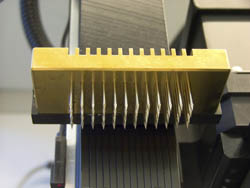Microarrays to detect protein–ligand interactions
Peptides are essential components of all living organisms, comprising parts of the cell structure or providing vital functions such as enzymatic reactions, metabolic processes and cellular signalling. As a result, analysing the protein structure and understanding the role of proteins in biological processes is of paramount importance for unveiling the mechanisms underlying various diseases. Given the diversity of proteins and their peptide components, a technology is required that would allow the simultaneous analysis of nearly all proteins of the human proteome. The rationale behind the EU-funded 'High-density peptide microarrays and parallel on-line detection of peptide-ligand interactions' (PEPCHIPOMICS) project was to develop an approach that would allow a wide-screen peptide microarray analysis. To this end, the consortium synthesised a cost-effective, protein-based microarray chip using light-directed photochemistry, which essentially entails the addition of amino acids onto the microarray chip. Optimisation led to the generation of a new high-resolution peptide microarray synthesiser that facilitated the simultaneous synthesis of several hundred thousand peptide fields and two million peptides per array. Partners were confident that this number of peptides is sufficient to represent the entire human proteome. The interaction between the peptide probes immobilised on the chip and their targets was measured using a novel, label-free technology. The incorporation of a video charge coupled device (CCD) camera allowed the collection of real-time data from all different spots. A data mining system suitable for analysing high-throughput peptide microarray data was also developed. A particularly interesting application of the peptide microarray chip was for the detailed characterisation of antibody epitopes. For this purpose, a comprehensive collection of short 15 amino acid-long peptide sequences was used on the chip to map the antibody binding epitopes precisely. Other applications of this technology included the mapping of immune T cell specificities by determining the peptides that bind to major histocompatibility antigen (MHC) receptors. This is of high relevance for identifying potentially allergenic or autoimmune epitopes. Collectively, the potential applications of the PEPCHIPOMICS peptide microarray render it an invaluable tool for investigating protein functions in health and disease in an efficient and cost-effective way. Furthermore, the generated information could pave the way for the development of peptide-based medicines.







